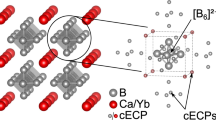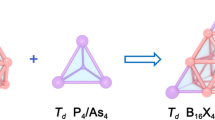Abstract
Boron carbides, B1-xCx with 0.085 ≤ × ≤ 0.200, generally contain both B12 and B11C icosahedra. However, the electronic transport with 0.1 ≤ × ≤ 0.2 is believed to occur by means of bipolaron hopping between only B11 C icosahedra [i]. We have calculated the changes in energy, atomic positlions and charge distribution when a pair of electrons is added to the isoelectronic icosahedral clusters B12 and (B11C)+. We simulate an icosahedron in a neutral lattice by bonding the icosahedral atoms to hydrogenic atoms which we constrain to be neutral. The computations are performed with a self-consistent molecular-orbital method, PRDDO.
We find a total energy reduction of -3.7 eV for two electrons added to a B12 icosahedron. Of this, -2.7 eV arises from the electrons filling the icosahedron’s bonding orbitals. The remaining -1.0 eV comes from the contraction of the icosahedron’s radius by -0.09 Å. For two electrons added to a (B11C)+ icosahedron we find a total energy reduction of -18.2 eV. Of this, -16.5 eV arises from filling the icosahedron’s bonding orbitals. The remainder arises frop a -0.09 Å contraction of the icosahedron’s radius. Thus, we find (B11C) icosahedra to be strongly energetically favored over B12 icosahedra as bipolaron sites.
The positive charge associated with a (B11C)+ icosahedron is distributed over the eleven boron atoms. Concomitantly, we find the added two electrons of the bipolaron to be distributed over all twelve sites of the B11C icosahedron. We find the energy difference between an electron pair added to B12 and (B11C)+ icosahedra to arise principally from the increased Coulomic attraction provided by the extra positive charge of the (B11C) icosahedron.
Similar content being viewed by others
References
D. Emin, in Boron-Rich Solids, edited by D. Emin, T. L. Aselage, C. L. Beckel, I. A. Howard and C. Wood (American Institute of Physics, New York, 1986), p. 189.
D. Emin, G. A. Samara and C. Wood, in Proceedings of the 17th Internation Conference on the Physics of Semiconductors, editors J. D. Chadi and W. A. Harrison (Springer-Verlag, New York, 1985), p. 1349.
L. J. Azevedo, E. L. Venturini, D. Emin and C. Wood, Phys. Rev. B32, 7970 (1985).
C. Wood and D. Emin, Phys. Rev. B29, 4582 (1984).
W. N. Lipscomb, Boron Hydrides (Benjamin, New York, 1963), Chap. 1.
I. A. Howard, D. Emin and C. L. Beckel, Phys. Rev. B35, 2929 (1987).
I. A. Howard, C. L. Beckel and D. Emin, Phys. Rev. B35, June 15 (1987).
H. Yakel, Acta Crystallogr. Sect, b 31, 1797 (1975).
R. K. Bohn and M. D. Bohn, Inorg. Chem. 10, 350 (1971).
T. A. Halgren and W. N. Lipscomb, J. Chem. Phys. 58, 1569 (1973).
Author information
Authors and Affiliations
Rights and permissions
About this article
Cite this article
Howard, I.A., Beckel, C.L. & Emin, D. Bipolaron Formation in B12 and (B11C)+ Icosahedra. MRS Online Proceedings Library 97, 39–43 (1987). https://doi.org/10.1557/PROC-97-39
Published:
Issue Date:
DOI: https://doi.org/10.1557/PROC-97-39




